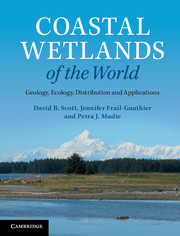Book contents
- Frontmatter
- Contents
- Preface
- List of acronyms and abbreviations
- 1 Introduction: what is covered in this coastal wetlands book?
- 2 Physical aspects: geological, oceanic and climatic conditions
- 3 Zonations and plants: development, stressors and adaptations
- 4 Animals in coastal wetlands: zonation, adaptations and energy flow
- 5 Human intervention causing coastal problems
- 6 Coastal wetlands worldwide: climatic zonation, ecosystems and biogeography
- 7 Examples of North American salt marshes and coastal wetlands
- 8 Examples of South American coastal wetlands
- 9 Africa: selected marsh and mangrove areas
- 10 Europe and Asia: a view of what remains
- 11 Australasia: wetlands of Australia and New Zealand
- 12 Applications in geological monitoring: paleoseismology and paleoclimatology
- 13 Applications in conservation of plant biodiversity and agriculture
- 14 Using mesocosms as a way to study coastal wetlands
- 15 Conclusions and future directions
- References
- Index
- Plate section
6 - Coastal wetlands worldwide: climatic zonation, ecosystems and biogeography
Published online by Cambridge University Press: 05 July 2014
- Frontmatter
- Contents
- Preface
- List of acronyms and abbreviations
- 1 Introduction: what is covered in this coastal wetlands book?
- 2 Physical aspects: geological, oceanic and climatic conditions
- 3 Zonations and plants: development, stressors and adaptations
- 4 Animals in coastal wetlands: zonation, adaptations and energy flow
- 5 Human intervention causing coastal problems
- 6 Coastal wetlands worldwide: climatic zonation, ecosystems and biogeography
- 7 Examples of North American salt marshes and coastal wetlands
- 8 Examples of South American coastal wetlands
- 9 Africa: selected marsh and mangrove areas
- 10 Europe and Asia: a view of what remains
- 11 Australasia: wetlands of Australia and New Zealand
- 12 Applications in geological monitoring: paleoseismology and paleoclimatology
- 13 Applications in conservation of plant biodiversity and agriculture
- 14 Using mesocosms as a way to study coastal wetlands
- 15 Conclusions and future directions
- References
- Index
- Plate section
Summary
Key points
All wetland ecosystems provide valuable services to local people and influence global carbon budgets; climate delimits four major ecosystems: arctic and subpolar marshes, temperate marshes, subtropical tidal wetlands and tropical mangrove swamps; wetlands worldwide have specialized plant forms adapted to physical extremes of soil salinity, instability and low oxygen; global biogeographic studies are the tools of wetlands biodiversity studies; primary regional differences in species composition reflect ancient paleogeographic changes; plate tectonics and icesheets isolated tropical ‘Old World’ from ‘New World’ biological provinces; coastal wetlands are azonal vegetation types highly influenced by soil conditions; differences in temperature and precipitation regimes shift the ecosystem boundaries north or south on different coasts of continents; seasonal variations in temperature–precipitation conditions drive subregional soil water salinity differences.
In this chapter, general distinctions (both physical and biological features) of major latitudinal and climatic zones are outlined, so the reader can appreciate the broad similarities and dramatic differences in coastal wetlands across the globe (Chapters 7 to 11). We also look at the phytogeographical variations found on different coasts of the same continent and explain why the tropical floras of Atlantic and Pacific regions often are different, even within the same latitudinal range.
Climate zones and coastal wetland ecosystems
On a worldwide basis, there are four broad latitudinal zones of tidal wetlands (Figure 1.1). These world coastal wetland zones are: arctic and subpolar marshes; temperate zone marshes; subtropical marshes and mangroves; and tropical mangrove swamps. Each of these major ecosystems comprises a set of biological components interacting with their physical environment and providing characteristic wetland services (Figure 6.1) These services are defined by the Ramsar Convention as ‘the benefits people obtain from ecosystems, including provisions (food and water), regulating functions (buffering from floods and storms), nutrient cycling, and cultural needs (recreation, spiritual, and esthetic qualities)’. The vital services for human wellbeing include water purification and nitrate detoxification, climate regulation through sequestering and releasing of carbon in the biosphere, and mitigation of climate-driven sea level rise and storminess, which can result in erosion and devastating coastal floods (Millennium Ecosystem Assessment, 2005). Barbier et al. (2011) provide further details of the quality of estuarine and coastal ecosystem services and they estimate the financial losses to be expected from elimination of these services.
- Type
- Chapter
- Information
- Coastal Wetlands of the WorldGeology, Ecology, Distribution and Applications, pp. 57 - 71Publisher: Cambridge University PressPrint publication year: 2014
- 1
- Cited by



